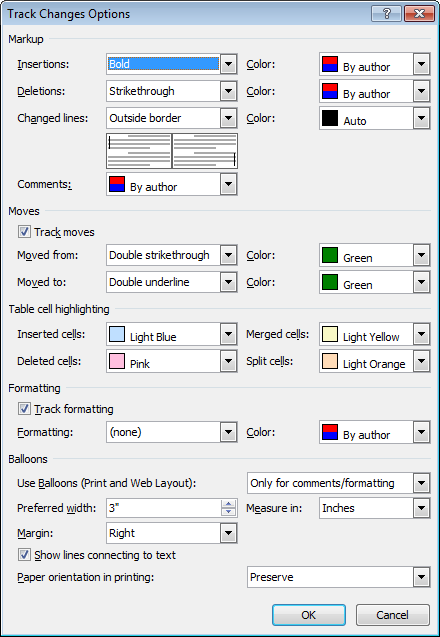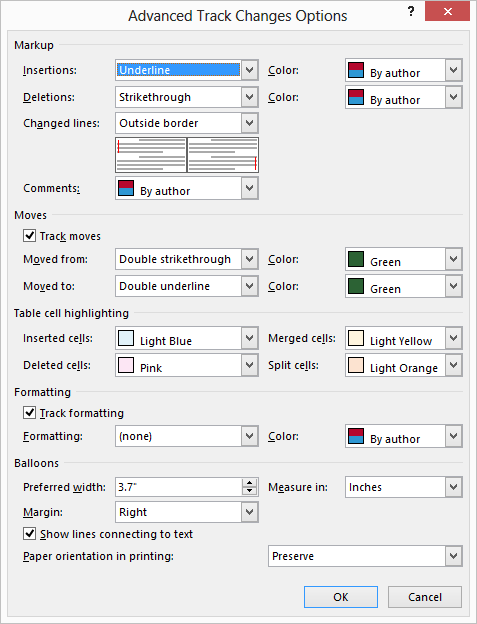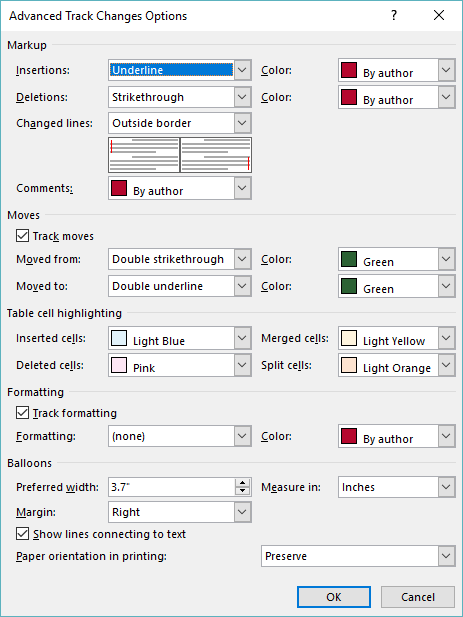Written by Allen Wyatt (last updated March 27, 2023)
This tip applies to Word 2007, 2010, 2013, 2016, 2019, and 2021
Martha works for an attorney who uses Track Changes a lot when working with clients. He is annoyed by having to turn track formatting off all the time. (He doesn't want simple formatting changes to be tracked.) Plus, when he passes the document to a client (via email), if they don't know how to turn off the tracking of formatting changes, the returned document is always full of tracked formatting changes. Martha wonders if there is a way she can turn off the tracking of formatting changes forever.
When you turn on Track Changes in Word, the program tracks lots of changes you make. One category of changes it can track are changes to formatting. Fortunately, you can control the types of changes that Word actually tracks. This is what Martha does—she turns off one specific category of changes (formatting) so that Word doesn't track those; it only tracks other types of changes.
How you adjust the categories of changes that Word tracks varies based on the version of Word you are using. To turn off the tracking of formatting, you would follow these steps if you are using Word 2007 or Word 2010:

Figure 1. The Track Changes Options dialog box.
If you are using Word 2013, follow these steps instead:

Figure 2. The Advanced Track Changes Options dialog box in Word 2013.
Finally, if you are using Word 2016 or a later version of the program (including the version provided with Office 365), follow these steps:

Figure 3. The Advanced Track Changes Options dialog box in Word 2016.
So far, so good. Right? Well, not really. The problem is that making this setting isn't always sticky. Some people say that the change will travel with the document; others say that it doesn't. Still others say that the change will reset if you turn Track Changes off and then turn it on again.
From what I've been able to determine, the persistence of this setting will vary based on the version of Word you are using. Thus, if the change is persistent for documents on your system, once you send the document off to someone else and if they use a different version of Word, you may get back a document that has the setting turned back on and all formatting changes are marked. This can be very frustrating.
In my experience, you need to undertake a three-pronged approach. First, you need to open your Normal template and clear the Track Formatting check box within it. Once you make the change and save the Normal template, any future documents you create that are based on that template won't track formatting changes when Track Changes is turned on. (This only applies, of course, if your version of Word doesn't reset the Track Formatting check box when you turn Track Changes on and off.)
The second thing you need to do is to open any existing documents and make sure the setting is turned off for those documents. (The change you made to the Normal template won't affect any previously created documents; it only affects new documents created after you make the change.) Obviously, this step may take a while to do if you have quite a few documents.
The third thing you need to do is to get rid of any tracked formatting changes that may appear when you receive a document from someone else. This is necessary, again, be because you have no control over how that person's system is configured. You can get rid of just the tracked formatting by following these steps:
The result of these steps is that you'll only see in the document all of the changes except formatting changes—just as you want. The downside to this is that you'll need to do it on all documents you receive from others, now and forever.
There are macro-based approaches you can follow, if you desire. Adding a simple AutoOpen macro to all your documents can be a huge timesaver in the long run:
Sub AutoOpen()
ActiveDocument.TrackFormatting = False
End Sub
This simple macro turns off the tracking of formatting whenever the document is opened. This will even work with documents you send to others, provided they don't disable macros when they open your document.
You'll need a different macro to get rid of any tracked formatting that may appear in documents you receive from others. The following will do the trick:
Sub AcceptChangedFormatting()
Dim r As Revision
For Each r In ActiveDocument.Revisions
If Left(r.FormatDescription, 10) = "Formatted:" Then r.Accept
Next r
End Sub
You can assign this macro to a shortcut key or to a button on the QAT. When it is invoked, all the formatting changes in the document are immediately accepted and you can then continue to work with other changes that were tracked in the document.
WordTips is your source for cost-effective Microsoft Word training. (Microsoft Word is the most popular word processing software in the world.) This tip (7839) applies to Microsoft Word 2007, 2010, 2013, 2016, 2019, and 2021.

Discover the Power of Microsoft Office This beginner-friendly guide reveals the expert tips and strategies you need to skyrocket your productivity and use Office 365 like a pro. Mastering software like Word, Excel, and PowerPoint is essential to be more efficient and advance your career. Simple lessons guide you through every step, providing the knowledge you need to get started. Check out Microsoft Office 365 For Beginners today!
Macros allow you to easily extend what you can do with Word. If you have a common editing task, that task can often be ...
Discover MoreGot a document layout that requires a portion of the page to be in one layout and another portion to be in a different ...
Discover MoreDrag-and-drop editing is a handy feature when you love to use the mouse. There are two ways you can move text using the ...
Discover MoreFREE SERVICE: Get tips like this every week in WordTips, a free productivity newsletter. Enter your address and click "Subscribe."
2025-11-30 03:23:45
sandeep kothari
Wonderful article & discussion / comments.
2024-06-24 11:01:32
Paul Stregevsky
Merritt,
This article is about Track Changes. I suggest you check out Allen's articles about Building Blocks: https://wordribbon.tips.net/C0865_Building_Blocks.html
2024-06-21 18:23:41
Merritt Robinson
I am using Word from Office 365 and anytime I try to access any part of Quick Parts or even a Page Number, I get a pop-up that says: '(Word cannot open this document template. (C:\Users\Admin]\...\~$ilding Blocks.dotx)'.
I can't even find any file that ends with 'ilding Blocks.dotx', much less fix/replace it. What can I do to regain access to these functions?
2023-07-20 22:16:58
Ken Endacott
Sub AcceptChangedFormatting()
Dim r As Revision
For Each r In ActiveDocument.Revisions
If Left(r.FormatDescription, 10) = "Formatted:" Then r.Accept
Next r
End Sub
This macro has problems in Word 2016 and Word 2019. If there are more than 3400 revisions an error 5852 will occur at about the 3340th revision halting the execution and in the case of Word 2019 it may corrupt the document. The error cannot be trapped with an On Error statement. I don’t know if it is present in Word versions prior to 2016 but the problem seems to be fixed in Word 2021.
It might seem that 3400 revisions is a lot but it is not uncommon to have several thousand revisions in a large document, in a real world example there were 7000 revisions in a 400 page thesis. Many organisations and clients of editors insist that Track Changes is active for all editing. Editors often use Track Changes to demonstrate that they have earned their fee.
2023-07-03 11:30:17
pk chaudhary
This has been really useful.
Many other tips have been useful too.
2023-04-04 09:49:55
Griffin
This is really poor design by Microsoft to have this kind of setting not be user-based but rather per-document. While it would be good to have the per-document tracking settings follow that file, there should be a default setting as a user-controlled one that applies, and must be modified on a per-document basis. That the setting being changed (application/program level) doesn't follow to individual documents/files is, in my opinion, a design flaw at a minimum, and a bug at worst. Just another example of problems that have perpetuated under a Microsoft monopoly.
2020-03-15 18:06:11
I use MS Word 2016. In stark contrast with MS Word 2007, every single time I click on "Track Changes" in a document that already has tracked changes, the right pane displays a bunch of formatting junk. To be rid of it, I have to de-select "Show Formatting".
This is a nuisance. I do not use it and it has no value whatever to me.
What macro coding could I apply to disable "Show Formatting" in MS Word 2016?
Microsoft purports to offer a solution at the URL below, but it does not work:
https://docs.microsoft.com/en-us/office/vba/api/word.view.showformatchanges
Thanks.
WR Smith
2020-03-15 16:06:23
I use MS Word 2016. In stark contrast with MS Word 2007, every single time I click on "Track Changes" in a document that already has tracked changes, the right pane displays a bunch of formatting junk. To be rid of it, I have to de-select "Show Formatting".
This is a nuisance. I do not use it and it has no value whatever to me.
What macro coding could I apply to disable "Show Formatting" in MS Word 2016?
Microsoft purports to offer a solution at the URL below, but it does not work:
https://docs.microsoft.com/en-us/office/vba/api/word.view.showformatchanges
Thanks.
WR Smith
2019-12-12 09:37:14
Andrew
Mr. Steenhuyse, it is not that Protected View interrupts your AutoOpen macro, it's that the change you are trying to make is disallowed while Protected View is active. I have discovered that AutoOpen is called when a protected document is first opened in protected view, and it is called a second time when editing is enabled on it - you'll need to skip the disallowed tasks at the time of the initial opening. Here is a skeleton version of the way I do it:
Function ActiveDocumentProtected() As Boolean
ActiveDocumentProtected = Not ActiveProtectedViewWindow Is Nothing
End Function
Sub AutoOpen()
If Not ActiveDocumentProtected Then
' Do stuff
End If
End Sub
2019-12-11 02:49:32
TTG
Wonderfully helpful! Another annoying task crossed off my list. Thank you os much for this. To uncheck the Formatting box in the (main) Track Changes Options dialog box (i.e., not the Advanced dialog box), I've added a second line:
Sub AutoOpen()
ActiveDocument.TrackFormatting = False
ActiveDocument.ActiveWindow.View.ShowFormatChanges = False
End Sub
Works like a charm. Cheers!
2019-05-02 11:58:44
Steven J. Van Steenhuyse
The AutoOpen macro in this tip is awesome and solves a lot of my issues with Track Changes. However, I frequently receive Word documents as email attachments. I have Protected View turned on for email attachments. When I open one of these documents, I get a Visual Basic pop-up indicating run-time error 4248, and I have to click "End" before I can read or enable editing of the document. I assume that Protected View interrupts the AutoOpen macro, which generates the run-time error. Is there a way to tweak the AutoOpen macro so that it recognizes that a document is in Protected View, and prevents running the macro until editing is enabled?
2019-04-23 09:54:03
Lilli Hausenfluck
This is extremely helpful. Thanks to all who contributed. I'd like to turn off the other tracking button called Track Moves at the same time as I turn off Track Formatting. What would I add to the AutoOpen macro? Would it be "ActiveDocument.TrackMoves = False"? Thanks for any help with this.
Got a version of Word that uses the ribbon interface (Word 2007 or later)? This site is for you! If you use an earlier version of Word, visit our WordTips site focusing on the menu interface.
Visit the WordTips channel on YouTube
FREE SERVICE: Get tips like this every week in WordTips, a free productivity newsletter. Enter your address and click "Subscribe."
Copyright © 2026 Sharon Parq Associates, Inc.
Comments